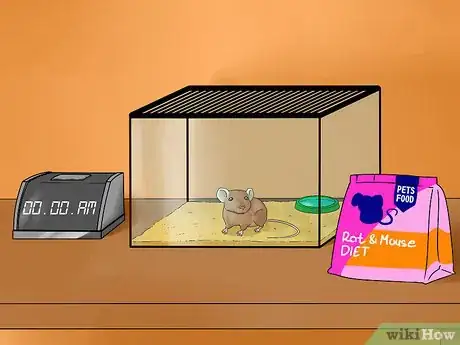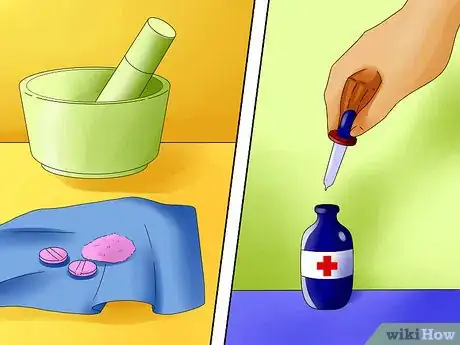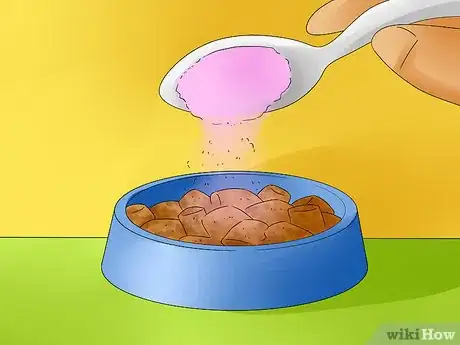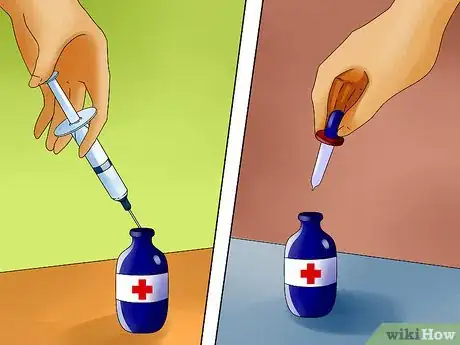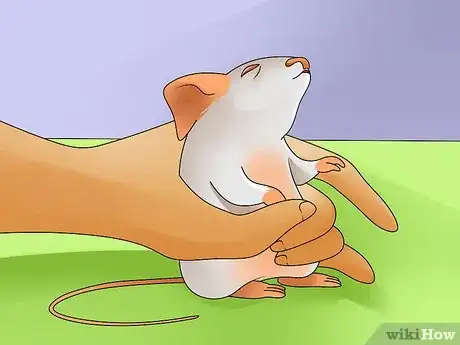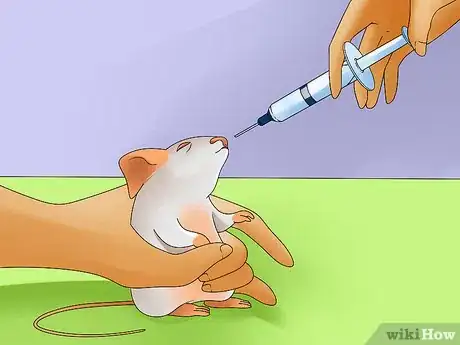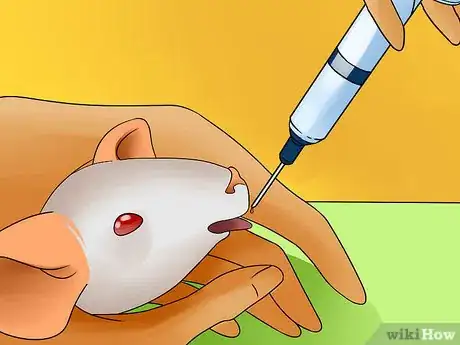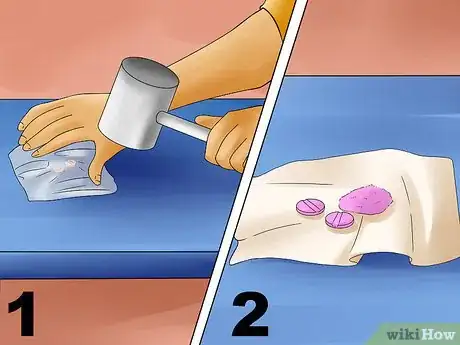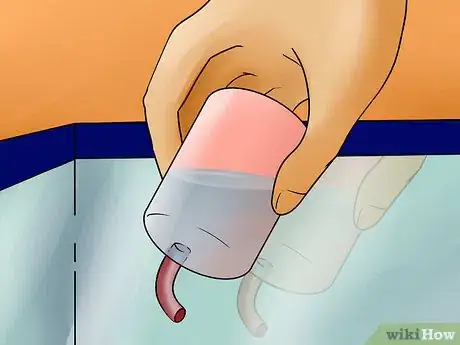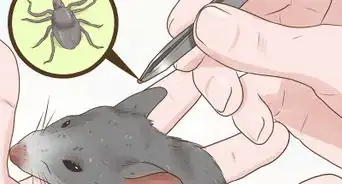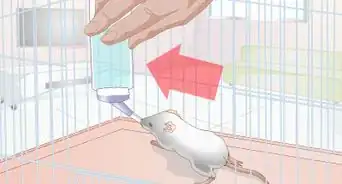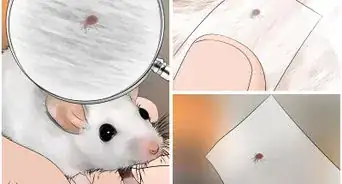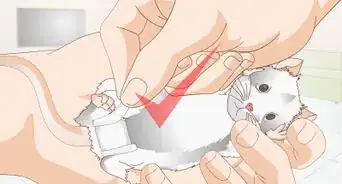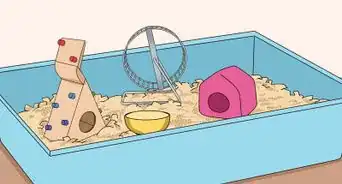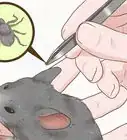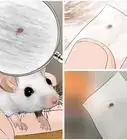This article was co-authored by Alisa Rassin. Alias Rassin is an Exotics Veterinarian and the Owner of The Exotic Animal Hospital of Pennsylvania in Lansdowne, Pennsylvania. With over a decade of experience, she specializes in treating reptiles, birds, and small mammals. She holds a Veterinariae Medicinae Doctoris from The University of Pennsylvania and a BS in Veterinary Biomedical and Clinical Sciences from Penn State University. She was also certified by the Royal College of Veterinary Surgeons.
This article has been viewed 43,934 times.
Do you need to give a pet mouse or small rodent a dose of medicine? Or, do you need to administer oral medication in a laboratory setting? Either way, keeping the animal calm and ensuring that it takes the full dose of its medication is crucial! Fortunately, there are a few simple ways you can do this.
Steps
Disguising the Medication with Food
-
1Withhold food from your mouse or rodent overnight. Since the medication may have a funny taste to it, fast your mouse or rodent to get it to eat the medication mixture. Leave your mouse’s water in its enclosure, but remove the food dish and any bits of food from its enclosure the night before giving the medication.
- Make sure that you administer the medication first thing in the morning, and then replace your mouse’s food after it has taken the medicine.
-
2Crush the tablet or measure out the required dose of liquid medication. Check the medication bottle to find out how much medication to administer. Then, place the tablet into a plastic bag and smash it with the blunt side of a meat hammer or roll over it with a rolling pin. If the medication is in liquid form, then measure out the required amount of liquid medication with an eyedropper or syringe.[1]Advertisement
-
3Mix the medication with ¾ tsp (~4 g) of food that the rodent likes. Empty the powder or liquid into a small bowl and add ¾ tsp (~4 g) of food. Mix the medication and food until they are well combined. Some good options include sugar cookie dough, yogurt, whipped cream, mashed bananas, pudding, gravy, and peanut butter.[2]
- Stir the medication into a soft food, such as yogurt, mashed banana, or pudding, or knead the medication in if you are using sugar cookie dough.[3]
-
4Give the food to the rodent and make sure the rodent eats it. Place the medication and food mixture in your rodent’s food dish instead of its normal food. Then, observe the rodent to ensure that it eats all of the food. After the rodent has consumed the medicine-laced food, put its normal food back into the dish.[4]
- If the rodent will not eat the medication mixture, try a different method of administration.
- If the rodent eats some of the food, do not administer another dose. Try a different method of administration for the next scheduled dose.
Tip: Sometimes a mouse will love a food for a few days, and then refuse to eat it. If this happens, try mixing something different in with the medication.
Using an Oral Medicine Syringe
-
1Place a dose of the medication into a needleless syringe. Depress the plunger completely, and then place the tip of the syringe against the mouth of the medicine bottle. Pull back on the plunger to fill the barrel with the required dose of medication. Check the medication bottle if you are unsure.[5]
- You may also use an eye dropper to administer the medication. Squeeze the bulb on the dropper and place the tip of the dropper against the mouth of the medicine bottle. Then, release the bulb slowly to pull the required amount of medicine into the barrel.
- You can find medicine syringes and droppers in a drug store, or ask your rodent’s veterinarian for one.
-
2Hold the rodent upright in your non-dominant hand. Position the rodent so the rodent’s head is in the crook between your index finger and thumb. Grip the rodent firmly but gently with your fingers. Make sure that it cannot get loose.[6]
- If you are concerned that your rodent may bite or scratch you, wear a thick leather or canvas glove over the hand you are using to hold the rodent.
-
3Squeeze the syringe to dispense a drop of medication that the rodent can lick off. Place the tip of the syringe about 0.5 in (1.3 cm) away from your rodent’s mouth. Then, depress the plunger very slightly to squeeze out a drop of the medication. See if the rodent will lick the medicine off of the tip of the barrel. If it does, then continue to dispense a small amount at a time and let your rodent lick it off the tip.[7]
- If you accidentally get some of the medicine on your rodent's fur, don't worry about it. Your rodent will likely lick off the medicine as it grooms itself.
Tip: The rodent may be more likely to lick the medicine if it is flavored or if you mix it with a small amount of liquid that the rodent likes, such as gravy.
-
4Insert the syringe into the rodent’s mouth to dispense it if it will not lick the medicine. If your rodent is reluctant to lick the tip of the barrel, then gently insert the tip into the rodent’s mouth. Squeeze about 1/4 to 1/3 of the dose into your rodent’s mouth and wait for it to swallow the medicine. Wait for a few seconds and then administer another 1/4 to 1/3 of the dose. Repeat this until the rodent has taken the full dose.[8]
- Be careful not to insert the tip of the dropper or syringe too far into the rodent’s mouth or down into its throat. Doing this may damage its esophagus.
Dissolving the Medication in Water
-
1Crush the tablet or measure out the required dose of liquid medication. Place the tablet in a plastic bag, then smash the tablet. Use the blunt side of a meat hammer or a rolling pin to crush the tablet, or use an eyedropper or syringe to measure out a dose of liquid medication. Remember to check the medication bottle for dosage information.[9]
-
2Dissolve the medication in 15 mL (0.51 fl oz) of water in the rodent’s water bottle. Make sure to crush the medication first if it is in tablet form. Then, add about 15 mL (0.51 fl oz) of water to the bottle. Swirl the water and medication together to combine them.[10]
- Placing your mouse or rodent’s medication in with its water may work if you cannot get the rodent to take the medication mixed in with food, or if the rodent is not supposed to have food with the medication. However, some rodents will object to the taste of the water/medication solution and refuse to drink it.
-
3Place the water bottle in the rodent’s enclosure. After you have mixed the medication in with the water, screw the spout back onto the water bottle. Then, hang the bottle in its usual spot in your rodent’s enclosure.[11]
- Make sure that the spout is screwed on tightly to prevent the bottle from leaking medication fluid into the rodent’s enclosure.
-
4Ensure that the rodent drinks all of the medicated water. Observe the rodent to see if it is interested in the water. Check the bottle once per hour over the next few hours to see if the rodent is drinking it. If the rodent refuses to drink the medicine water, then you will need to administer the medication in a different way.[12]
- Be sure to fill the water bottle with normal drinking water after the rodent has finished drinking the fluid.[13]
Tip: If the rodent is reluctant to drink plain water mixed with medication, try adding 1 tsp (5 g) of sugar in with the water as well.
Expert Q&A
-
QuestionCan betamox be mixed together with loxicom in food?
 Pippa Elliott, MRCVSDr. Elliott, BVMS, MRCVS is a veterinarian with over 30 years of experience in veterinary surgery and companion animal practice. She graduated from the University of Glasgow in 1987 with a degree in veterinary medicine and surgery. She has worked at the same animal clinic in her hometown for over 20 years.
Pippa Elliott, MRCVSDr. Elliott, BVMS, MRCVS is a veterinarian with over 30 years of experience in veterinary surgery and companion animal practice. She graduated from the University of Glasgow in 1987 with a degree in veterinary medicine and surgery. She has worked at the same animal clinic in her hometown for over 20 years.
Veterinarian These medications do two different things. One is an antibiotic, while the other is an anti-inflammatory. You shouldn't have any issues mixing the two, and they'll mix in the rodent's stomach anyway.
These medications do two different things. One is an antibiotic, while the other is an anti-inflammatory. You shouldn't have any issues mixing the two, and they'll mix in the rodent's stomach anyway.
Things You’ll Need
Disguising the Medication with Food
- Liquid medicine or tablet
- Syringe or eyedropper (for measuring liquid medication)
- Plastic bag and meat hammer or rolling pin (for crushing solid medication)
- ¾ tsp (~4 g) of food your rodent likes, such as sugar cookie dough, yogurt, whipped cream, mashed bananas, pudding, gravy, or peanut butter
- Food dish
Dissolving the Medication in Water
- Water bottle
- Water
- Liquid medicine or tablet
- Syringe or eyedropper (for measuring liquid medication)
- Plastic bag and meat hammer or rolling pin (for crushing solid medication)
Using an Oral Medicine Syringe
- Oral medicine syringe or eye dropper
- Liquid medicine
- Leather or canvas glove
Expert Interview
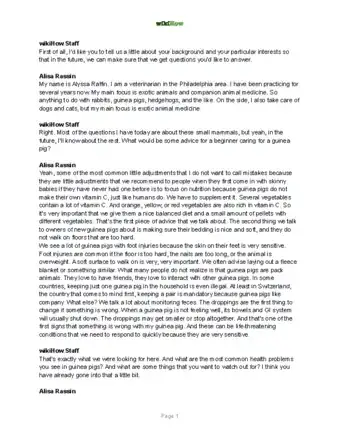
Thanks for reading our article! If you'd like to learn more about giving medication to a mouse, check out our in-depth interview with Alisa Rassin.
References
- ↑ http://ratguide.com/meds/basics/giving_medications.php
- ↑ http://ratguide.com/meds/basics/giving_medications.php
- ↑ https://journals.sagepub.com/doi/full/10.1258/la.2012.012018
- ↑ https://www.bu.edu/researchsupport/compliance/animal-care/working-with-animals/procedures/administration-of-drugs-and-experimental-compounds-in-mice-and-rats/
- ↑ http://ratguide.com/meds/basics/giving_medications.php
- ↑ http://ratguide.com/meds/basics/giving_medications.php
- ↑ http://ratguide.com/meds/basics/giving_medications.php
- ↑ http://ratguide.com/meds/basics/giving_medications.php
- ↑ http://ratguide.com/meds/basics/giving_medications.php
- ↑ http://www.vspn.org/vspnsearch/aow/drugtherapyinpetrodents.htm
- ↑ http://www.vspn.org/vspnsearch/aow/drugtherapyinpetrodents.htm
- ↑ http://www.vspn.org/vspnsearch/aow/drugtherapyinpetrodents.htm
- ↑ https://www.bu.edu/researchsupport/compliance/animal-care/working-with-animals/procedures/administration-of-drugs-and-experimental-compounds-in-mice-and-rats/
About This Article
To give a mouse or small rodent oral medication, try mixing the medication with food that your rodent really likes, like sugar cookie dough, yogurt, or mashed banana. If the medication is a pill, crush it up before you mix it into the food. You can also try dissolving the medication in your rodent's water bottle. Just make sure it drinks all of the water, and add a teaspoon of sugar to the water if it seems reluctant to drink it. For more tips from our Veterinary co-author, like how to give your rodent medication using an oral medicine syringe, scroll down!
